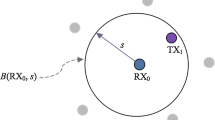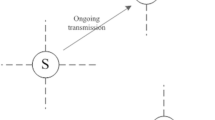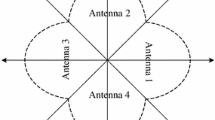Abstract
A medium access control (MAC) protocol (NULLHOC) for ad hoc networks of nodes with antenna arrays is presented. The antenna array is used for transmit and receive beamforming with the purpose of increasing spatial reuse by directing nulls at active transmitters and receivers in the neighborhood. In contrast to previous work with directional antennas, our approach is applicable to multipath channels, such as occur indoors or in other rich scattering environments. The MAC protocol is designed to support the control information exchange needed to direct nulls toward other users involved in existing communication sessions. Knowledge of the channel coefficients between a transmitter or receiver and its neighbors is used to design transmit or receive beamformer weights that implement the requisite nulling. Simulations are used to demonstrate the improvements in throughput and transmit powers that are obtained in this approach relative to the IEEE 802.11 MAC protocol. We also analyze the effects of channel estimation errors on our protocol and propose a simple modification of the basic (NULLHOC) protocol to minimize their impact.
Similar content being viewed by others
References
Wireless LAN medium access control (MAC) and physical layer (PHY) specifications, Tech. Rep. IEEE Local and Metropolitan Area Network Standards Committee (1999).
A. Naquib, N. Seshadri, and A. R. Calderbank, Increasing data rate over wireless channels, IEEE Signal Processing Magazine (May 2000) 76–92.
A. J. Paulraj and C. B. Papadias, Space time processing for wireless communications, IEEE Signal Processing Magazine, 14 (November 1997) 49–83.
S. D. Blostein and H. Leib, Multiple antenna systems: their role and impact in future wireless access, IEEE Communications Magazine 41(7) (July 2003).
J. G. Proakis, Digital Communications (McGraw-Hill, 2001).
T. K. Sarkar, Ji Zhong, Kim Kyungjung, A. Medouri, and M. Salazar-Palma, A survey of various propagation models for mobile communication, IEEE Antennas and Propagation Magazine 45(3) (June 2003) 51–82.
A. G. Goldsmith and S. G. Chua, Variable rate power MQAM for fading channels, IEEE Transactions on Communications 45 (October 1997) 1218–1230.
G. G. Raleigh and J. M. Cioffi, Spatio-temporal coding for wireless communications, IEEE Transactions on Communications (March 1998) 357–366.
E. de Carvalho and D. T. M. Slock, Maximum-likelihood blind FIR multi-channel estimation with Gaussian Prior for the symbols, in: Proceedings of ICCASP-97, 5 (April 1997) pp. 3593– 3596.
A. Grant, Joint decoding and channel estimation for linear MIMO channels, in: Proceedings of WCNC 3 (September 2000) pp. 1009–1012.
Z. J. Haas and J. Deng, DBTMA—A multiple access control scheme for ad hoc networks, IEEE Transactions on Communications 50 (February 2002) 975–985,.
S. M. Alamouti, A simple transmit diversity technique for wireless communications, IEEE Journal on Selected Areas in Communications 16(8) (October 1998) 1451–1458.
Y. Wang and J. J. Garcia-Luna-Aceves, Spatial reuse and collision avoidance in ad hoc networks with directional antennas, in: Proceedings of GLOBECOM 1 (November 2002) pp. 112–116.
B. Hassibi and B. Hochwald, How much training is needed in multiple-antenna wireless links, Technical memorandum, Bell Laboratories, Lucent Technologies (http://mars.bell-labs.com) (April 2000).
http://www.isi.edu/nsnam/ns/.
K. Sundaresan, R. Sivakumar, M. A. Ingram, and T. Chang, A fair medium access control protocol for ad-hoc networks with MIMO links, in: Proceedings of INFOCOM (2004).
Y. B. Ko, V. Shankarkumar, and N. H. Vaidya, Medium access control protocols using directional antennas in ad hoc networks, in: Proceedings of INFOCOM (2000).
A. Nasipuri, S. Ye, J. You, and R. E. Hiromoto, A MAC protocol for mobile ad hoc networks using directional antennas, in: Proceedings of IEEE Wireless Communications and Networking Conference (WCNC) (September 2000).
R. Ramanathan, On the performance of ad hoc networks with beamforming antennas, in: Proceedings of MOBIHOC (2001).
A. Spyropoulos and C. S. Raghavendra, Energy efficient communications in ad hoc networks using directional antennas, in: Proceedings of INFOCOM (2002).
N. S. Fahmy and T. D. Todd, Ad hoc networks with smart antennas using IEEE 802.11-based protocols, in: Proceedings of IEEE International Conference On Communications (ICC) 5 (April 2002) pp. 3144–3148.
A. Nasipuri, J. M. H. Manchala, and R. E. Hiromoto, On demand routing using directional antennas in mobile ad hoc networks, in: Proceedings of 9th International Conference on Computer Communications and Networks (2000), pp. 535–541.
S. Bandyopadhyay, K. Hasuike, S. Horisawa, and S. Tawara, An adaptive mac protocol for wireless ad hoc community network (WACNet) using electronically steerable passive array radiator antenna, in: Proceedings of GLOBECOM 5 (2001) pp. 2896– 2900.
T. ElBatt, T. Anderson, and Bo Ryu, Performance evaluation of multiple access protocols for ad hoc networks using directional antennas, in: Proceedings of WCNC 2 (March 2003) pp. 982– 987.
E. K. Onggosanusi, A. M. Sayeed, and B. D. Van Veen, Efficient signaling schemes for wideband space-time wireless channels using channel state information, IEEE Transactions on Vehicular Technology 52 (January 2003) 1–13.
J. P. Monks, V. Bhargavan, and W. W. Hwu, A power controlled multiple access protocol for wireless packet networks, in: Proceedings of INFOCOM (2001).
R. J. Muirhead, Aspects of multivariate statistical theory (New York: Wiley, 1982).
Author information
Authors and Affiliations
Corresponding author
Additional information
This work was supported in part by National Science Foundation grants ECS-9979408 and ANI-9980526. Any opinions, findings and conclusions or recommendations expressed in this publication are those of the author(s) and do not necessarily reflect the views of the funding agencies.
Rights and permissions
About this article
Cite this article
Mundarath, J.C., Ramanathan, P. & Van Veen, B.D. A cross layer scheme for adaptive antenna array based wireless ad hoc networks in multipath environments. Wireless Netw 13, 597–615 (2007). https://doi.org/10.1007/s11276-006-6364-1
Published:
Issue Date:
DOI: https://doi.org/10.1007/s11276-006-6364-1




